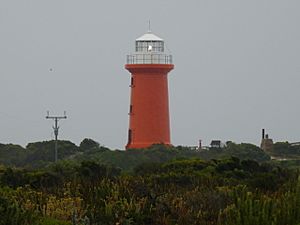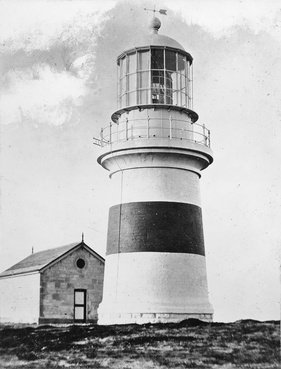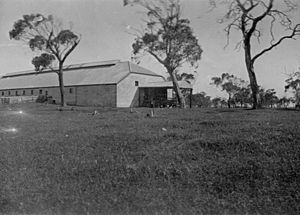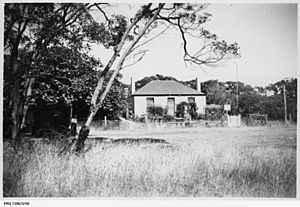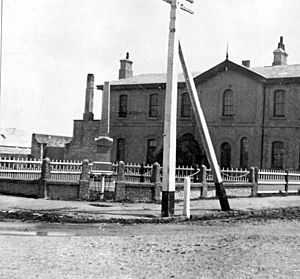List of state heritage places in the District Council of Grant facts for kids
This article is about special historic places in the District Council of Grant, a local area in South Australia. These places are called "state heritage places" because they are very important to the history and culture of South Australia. They are officially listed on the South Australian Heritage Register, which helps protect them for everyone to enjoy and learn from. Let's explore some of these amazing sites!
Contents
Historic Places in Grant Council
Cape Banks Lighthouse
The Cape Banks Lighthouse is located near Carpenter Rocks, inside the beautiful Canunda National Park. It became a heritage place on November 11, 1999. This lighthouse is super important for understanding the history of ships and how navigation tools developed in the late 1800s.
It also shows how lighthouse technology and design changed over time. The top part of the lighthouse, called the lantern house, is very special. It was actually used on an older lighthouse first! This lantern house is one of only three like it left in Australia. It has a unique fourteen-sided shape, just like another old lantern house at Cape Borda.
Cape Northumberland Lighthouse
The Cape Northumberland Lighthouse is found in Port MacDonnell, on a piece of land called Cape Northumberland. It was added to the heritage register on July 24, 1980.
This lighthouse, built in 1881, is important because it shows how much South Australia relied on the sea for travel and trade back then. There has been a lighthouse at Cape Northumberland since 1857, helping ships find their way safely.
Coola Shearing Shed
The Coola Shearing Shed is located in German Creek. It became a heritage place on April 11, 1996. The "Coola" property has been a successful farm for almost 140 years!
The shearing shed, built around the year 1900, is one of the biggest and most important shearing sheds in the South-East region. Other famous sheds include 'Mount Schank' and 'Glencoe'. The Coola property has connections to the South Australian Company and to Captain John Ellis, who was an important early settler in South Australia, and his family.
Dingley Dell Museum
The Dingley Dell Museum was once the home of a famous poet named Adam Lindsay Gordon. It's located in Port MacDonnell, within the Dingley Dell Conservation Park. This home became a heritage place on July 24, 1980.
Adam Lindsay Gordon lived here with his wife from 1864 to 1865. He arrived in the South East in 1853 and found lots of inspiration for his poems in the area. He was also known as a great horseman and steeplechase rider. There's a famous story about him making a dangerous jump over a fence near the Blue Lake at Mount Gambier! Dingley Dell was one of the first local museums in South Australia and the first one dedicated to a famous person. It opened in 1922.
Former Oast House and Attached Stone Building
This old building, called the Former Oast House and Attached Stone Building, is in Yahl on Caroline Forest Headquarters Road. It was added to the heritage register on May 28, 1981.
An "oast house" was used to dry hops, which are plants used to make beer. Hop farming started in the Yahl area in the 1870s and continued for some years. This building is made of rough stone with a steep, pyramid-shaped roof. It also has dressed limestone corners. Besides drying hops, this building was also used for church services, making it a place with a varied history.
Former Port MacDonnell Customs House
The old Port MacDonnell customs house is in Port MacDonnell on Charles Street. It became a heritage place on July 24, 1980.
This building was very important for the town. It was built to be a Customs House, where taxes on goods coming into the port were collected. It also served as a Court House and a Telegraph Office. Police officers and their families lived there too, with cells and stables at the back. It's a great example of a building that served many different public roles in the past.
German Style Cottage
This special house, known as the ‘German style cottage’, is located in Yahl on Ruwoldt Road. It was added to the heritage register on July 24, 1980.
The cottage is made of rough limestone with a steeply sloped roof, which is typical of "German Style" buildings. Many German settlers came to the Mount Gambier area, just like other parts of South Australia. They brought their unique building styles with them, and this cottage is a reminder of their influence and history in the region.
Mingbool Homestead and Stables
The Mingbool homestead and stables are located in Mingbool. They became a heritage place on June 29, 1989.
The homestead is made up of several parts built at different times. The oldest sections, including the original kitchen, are made of painted stone. These older parts are connected by a newer wooden section. The house has a mix of hipped and gabled roofs. The "Mingbool" Station was started in the early 1840s. After several owners, it was bought in 1877 by Mrs. Joanna Crowe and has stayed in her family ever since.
Mount Salt Limestone Track
The Mount Salt Limestone Track is in Mount Schank, next to McLeans Road. It was added to the heritage register on August 12, 2015.
This track is a rare and well-preserved example of a path made for specific animal-drawn vehicles. There aren't many other tracks like it in South Australia. It connected Mount Salt Station to the early road network. This track was originally just on the ground, but later it was cut through a limestone rock to make it easier and safer for people and small loads to travel.
It was most important from the 1870s to 1921, as it was a direct route between Mount Salt Station and Mount Schank Station, which was a huge farming operation. The track has three grooves, designed for carts or buggies pulled by a single animal or a line of animals. This design was unusual because it limited the types of vehicles that could use it. The track's design was never changed after 1921. It remains largely untouched, showing us how people and goods were transported long ago.
Pine Hall
The house known as ‘Pine Hall’ is in Suttontown. It was added to the heritage register on June 29, 1989.
Pine Hall is made of white painted dolomite and limestone. It has a hipped roof and a single-story verandah. The front of Pine Hall is two stories tall and looks very balanced, like buildings from the Georgian era. Caleb Fidler (1823-1874) and S.T. Webb started their famous general store in 1858 in a tiny building near where Fidler later built this house. He built Pine Hall after his business became successful.



